i didn't choose the haravatat life, the haravatat life chose me (genshin lore blog; mod is 25+; no shipping wank. currently playing: natlan AQs/WQs and exploration!)
Don't wanna be here? Send us removal request.
Text
so i have a new bluesky acct to crosspost on, and will hopefully be a little more accessible for any popcorn thoughts or short-form lore thoughts!
you can find it 🌱here 🌱
2 notes
·
View notes
Text
RUNNING IN HERE TO SAY I THINK I FINALLY FOUND OUT WHY LISA IS AFRAID OF PUMPKINS
(idk if this means she's not originally from Mondstadt, but it would be cool if so)
(also happy spooky-season i guess!!)

5 notes
·
View notes
Text
i have like absolutely nothing to say about natlan AQ so far bc it's been spitting so many facts at me. no speculation only good tasty answers
9 notes
·
View notes
Text
M A N i've been brewing up this theory about the Electro element having something to do with the Abyss for a while but if Natlan jumps the gun and proves me right before I get to post it I'm gonna be ticked
5 notes
·
View notes
Text
sorry i haven't rly posted anything here lately the burnout is real
1 note
·
View note
Text
IF YOU SAW THIS POSTED BEFOREHAND NO YOU DIDN'T
another twitter flop but maybe y'all will like this more


bonus: when HSR 2.2 came out it kinda...yeah

10 notes
·
View notes
Text
another twitter flop but maybe y'all will like this more


bonus: when HSR 2.2 came out it kinda...yeah

#genshin lore#genshin impact#hsr lore#honkai star rail#folklore and mythology#idk what else to tag this as... bible?? biblical lore?#lore bites
10 notes
·
View notes
Text
And if Wanderer's at the mines...Tatarasuna???
so i'm not quite done with the summertime event but just to get things straight, we currently have:
- a "kingdom of breezes and bells" whose main feature is a tavern that imbues its residents with life
- a bustling metropolis where a Geo king rules from a large palace high above everyone else, and many of the citizens work in a big mine
- an isolated area where a dragon "ate the end of the world" and spat out a huge fog that obscured an entire island
if that's not the first three nations I'll eat my own slimy rock hat.
19 notes
·
View notes
Text
so i'm not quite done with the summertime event but just to get things straight, we currently have:
- a "kingdom of breezes and bells" whose main feature is a tavern that imbues its residents with life
- a bustling metropolis where a Geo king rules from a large palace high above everyone else, and many of the citizens work in a big mine
- an isolated area where a dragon "ate the end of the world" and spat out a huge fog that obscured an entire island
if that's not the first three nations I'll eat my own slimy rock hat.
19 notes
·
View notes
Text
And yes, I do have a theory about her already.
So clearly she looks like Himeko. But she isn't "Murata" (the Pyro Archon mentioned by Venti in the [dubiously canon] prequel manga). The name being given right now is Mavuika (possibly a reference to the Maori fire goddess, if Genshin wiki is on its mark).
A common thread among Pyro Vision users are their connection to their parents. And as far as we know, we haven't had a "real" Archon in place since Liyue- e.g. Ei replacing her twin, Nahida being a "failed" reincarnation, Furina being only the human half of her true self. (whether Venti and Zhongli are the "real" Archons is always up for debate. hehe.)
It could be possible that Mavuika is also a daughter of Murata. A literal daughter.

less interested in how she looks like Himeko and more interested in the Khaenriahn symbols on her glove and earring.
also that sure is a lot of gold. stares at Zhongli.
15 notes
·
View notes
Text

less interested in how she looks like Himeko and more interested in the Khaenriahn symbols on her glove and earring.
also that sure is a lot of gold. stares at Zhongli.
15 notes
·
View notes
Text
GUESS WHAT!!!!
as obnoxious as i am right now, if even ONE of the leak rumors about Scaramouche in 4.8 are true i am going to become. so much worse.
7 notes
·
View notes
Text

sorry, i can't post my lore, there's a cat on my book.
7 notes
·
View notes
Text
dammit dammit dammit i have another idea brewing in my head but idk if i have to finish my most recent draft first
I WANNA WRITE SOMETHING ABOUT EYE MOTIFS BUT ELECTRO MIGHT BE REALLY IMPORTANT BACKGROUND BEFORE I GET TO IT
1 note
·
View note
Text
hey so this is barely a fully formed thought but I'm playing through Clorinde's SQ and CAN I TALK ABOUT HOW MANY BELLS AND WHISTLES WENT OFF IN MY BRAIN WHEN I SAW THIS

10 notes
·
View notes
Text
i think few future genshin exploration moments will top doing Jazari's Ruin Golem Quest after playing the Sumeru Archon Quest, seeing the doors on the cabin and immediately going. wait a minute. i recognize those.


they're the same doors used in Dottore's Shouki no Kami workshop, the one built under the Akademiya.

and immediately understanding two things. 1) Dottore has been here before for sure 2) he's explored Khaenri'ahn technology out in the field and actively uses it in his projects
and right afterwards you find his research notes on the Golem lol. it was such a good payoff.


hoyoverse doesn't need to include small details like these. specially for a character that isn't playable and likely will never be (for morality reasons). but they still do and it's what makes the game so enjoyable to explore. introducing a character like Dottore, about whom we know few things and even fewer of them are confirmed in-game. who is set up to be important in later story chapters. and still including these little pieces hidden in World Quests for us to chase his trail.
the way in which hoyoverse manages to make it's characters active parts of the world, leaving evidence of their presence behind, a hundred years, two hundred years or however much before the story starts but still there for us to find. the fact that the note is signed as Zandik and not Dottore but players are still expected to recognize it, that they trust the audience to piece it together. it's what makes Teyvat feel like such an organic world! it's tough to pull off, and yet i think hoyoverse manages to quite satisfactorily :)
it's a similar reason to why i enjoy the Narzissenkreuz World Quests so much. chasing Rene's trail and slowly piecing together his research is really entertaining.
57 notes
·
View notes
Text
My Chemical Marriage
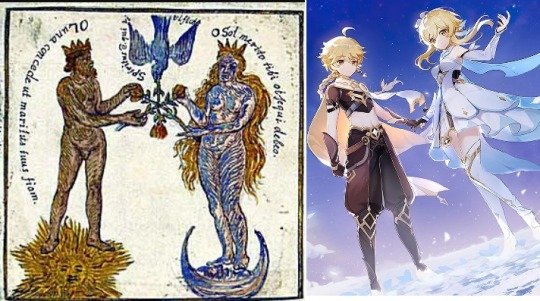
The chemical wedding is an allegory used in alchemical writings to refer to the union of opposites, particularly a union that produces a new and improved product, the Rebis.
One popular version of the allegorical wedding takes place between the Red King, the active principle (sulfur) that shapes the material and passive principle of the White Queen (mercury). However, this allegory can refer to the union of sun and moon, silver and gold, or even body and spirit.
The Rebis refers to the end product of the magnum opus, and is typically depicted as a hermaphrodite.

The child of the chemical marriage is sometimes called the philosopher’s child and fun fact, is associated with the myth of Orion and his three fathers (Jupiter, Mercury, and Neptune). The myth is very different but I can’t help but think of the Simurgh.
Though the chemical marriage allegory is very much referring to marriage and procreation, etc, in the context of Genshin, it’s used more to refer to a union of opposites, or a collaboration between two types of being, which will be elaborated on later. Of the four examples I will be going through, only two of these relationships have any kind of (canon) romantic associations attached to them. Basically what i’m trying to say is that this is definitely not about ships please don’t eat me.
It’s a well established trend in the history of Teyvat that there have been many god-king-like beings associated with gold or the sun, who had some kind of relationship with a knowledgeable and moon-associated woman, who then dies tragically during the god-king’s quest to Change The World.
And now, in thematic order, I present the doomed pairings:
Imunlaukr and the princess of Sal Vindagnyr
Imunlaukr is an outlander, destined to wield the Snow Tombed Starsilver sword to “shatter ice and snow.” The wiki cites a stanza where this name is used as a kenning for a sword. Imunlaukr tried to save Sal Vind from the catastrophic ice and snow caused by the Skyfrost Nail hitting an Irminsul tree, but he failed. Sal Vind had a princess who was also the daughter of the priestess of Vindagnyr, and was “born beneath this white tree” (Frostbearer). She is described as being “bright as the moonlight,” and had the gift of prophecy, painting her visions as frescos on the walls of the city - you can see them in the room where you find the Starsilver sword.
Guizhong and Zhongli
According to the Stone Tablet Compilations: Vol. I, Rex Lapis descended to Liyue. This isn’t the same descending as Descenders, and it has been argued that a better translation would be ‘demoted,’ but this has similarities to the way Deshret and Remus are described as founding their kingdoms. Rex Lapis is also called Deus Auri, the Golden God, and in the Dialogue of the Desert Sages description, it says that “transformation into gold and Mora is the sole province of Deus Auri.” Guizhong’s moon connection is on the weaker end, but she is strongly associated with glaze lilies, a flower that only blooms at night, like the Nilotpala, or Lunar, lotuses. She gave Zhongli a stone dumbbell, the Memory of Dust, which contains her “wisdom.” Zhongli is still unable to unlock it, and before Guizhong’s death, she told him to forget about its contents. On a more superficial note, Zhongli and Guizhong have a color scheme that will also be part of the pattern discussed here- black and gold and blue and white.
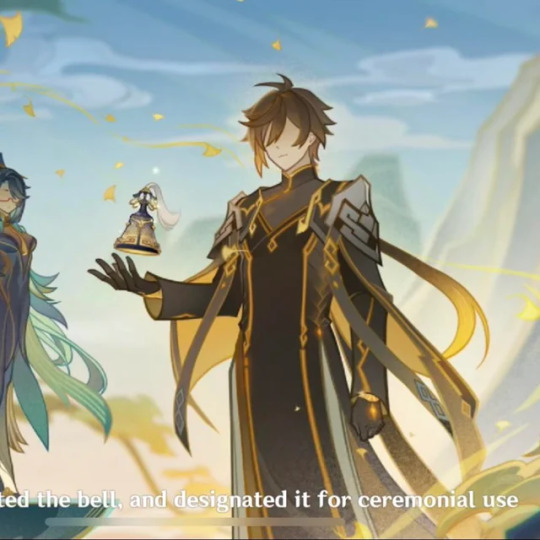
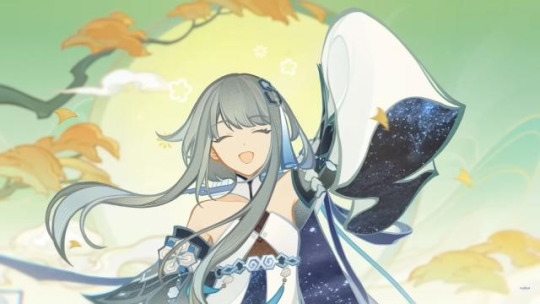
Remus and Sybilla
Sybilla was the former “envoy that protected the silver tree,” but she had lost her “mind and form.” However, she still retained her gift of prophecy, and told Remus about his destiny to found Remuria (and its inevitable downfall). Sybila’s loss of her physical form and mind is reminiscent of the Aranara stories about how Seelies were cursed to lose their body and intelligence if they fell in love with a human.

After making an arrangement with Remus, the silver tree that Sybilla was protecting transformed into a golden ship, which according to The History of the Decline and Fall of Remuria , was called Fortuna, and with it, Remus “descended” onto Meropis. Together with Sybilla, Remus created Phobos, the Great/Golden Symphony. Phobos is the name of one of the moons of Mars, the red planet. Combined with the Primordial Sea-derived ichor, it would allow his people to shed their physical forms and transcend their prophesied doom. Sybilla even sacrificed her life to make the symphony possible, but she wasn’t completely dead in the end, and her lack of “persona” led to the Symphony going awry.

And MOST IMPORTANTLY, the Golden Troupe of Remuria used a magical technique Rene called the “seal of chymical marriage,” and which I think was used to seal the Primordial Sea. Rene would later attempt to reverse its power to Evangelion-ify the people of Fontaine.
We don’t know what Remus or Sybilla actually looked like, but the color scheme of both the Remuria based artifact sets are white/blue/gold and black/blue/gold.


Decarabian and Amos
Decarabian was the god-king and founder of Mondstadt approximately 2600 years ago. He created a wind barrier to protect his people from the storms outside (and from Andrius), and in an effort to keep his people safe, micromanaged their lives, even banning certain kinds of music that could incite rebellion (Song of Broken Pines). Interestingly, his goal to protect his people is described as a ‘dream’ multiple times in item descriptions. The Scattered Piece of Decarabian's Dream: He tried so hard to make his dream come true, and so the fragments of that dream are still mighty.

Fragment of Decarabian’s Epic: If it were not for the song of freedom that shattered the city in an instant, Decarabian's dream would have gone on forever. I wonder if this is meant to be another incidence of the literal power of music, like Remus’s symphony, or the Source Song. |Decarabian had a human lover named Amos, although from her perspective, he did not understand her or her mortal love, or even the (lack of) devotion of his people. This reminds me of Scylla telling Remus that as a Usurper, he is cursed to love humanity. But maybe not understand them, which would be both of these god-kings’ downfalls. Though Amos was human, she also seems to have had prophetic dreams: "I dreamt of ocean waves and sand, of lush forests and land." "I dreamt of boars playing in berry bushes, of a towering spire." These words she spoke to the God King in a soft tone, but they were left unheard. (Amos’ Bow) Eventually, she would join the rebellion against him, and attempt to assassinate him. Amos also fits into the blue and white color scheme, and has a feather ornament similar to Lumine in her hair:
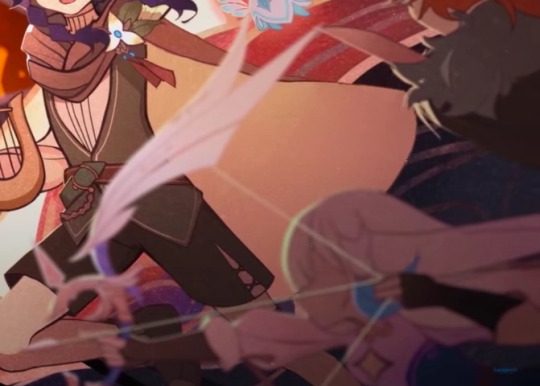
And we come to the piece de resistance. The ultimate example. One of the weirdest things in genshin lore (in a good way). I present:
Whatever TF is Going on With Deshret and the Goddess of Flowers
In The Lay of Al-Ahmar, Deshret is described as a “son of the sky,” with abilities that earned him the reverence of the tribes in the desert. One of his titles, Al-Ahmar, is Arabic for “the red one.” Deshret dreamed of creating a utopia for humans, and the final manifestation of that dream was the (failed) Golden Slumber, where like Remus, he attempted to separate his mind from his body. God-kings and their hiveminds…. Deshret received assistance in the form of access to forbidden knowledge from the Goddess of Flowers, also known as Nabu Malikata. The title Nabu refers to the Babylonian god of wisdom, who is associated with the planet Mercury in Babylonian astronomy. The title ‘Nabu’ has the same linguistic root as the Arabic ‘nabiyy’ (نبي) and Hebrew ‘navi’ (נביא), meaning prophet. According to Arama, the Goddess of Flowers was a survivor of the Seelie race. After her exile, she wandered the desert, where her blood turned into streams of water that allowed gardens of water lilies to grow, which in turn birthed the Jinn. Additionally, wherever she stepped, purple flowers called Padisarahs, described as “bearing semblance to the moon,” bloomed (Flower of Paradise Lost). Together with Deshret, she founded Ay-Khanoum, meaning "[City of the] Moon Maiden.” In addition to being known as “the red one,” Deshret is also known as the “Lord of Sand.” Combined with the Goddess of Flowers association with both water and mercury, I consider their respective titles to be a reference to Ibn Umayl’s Silvery Water and Starry Earth, a 10th century alchemical text. The ‘silvery water’ refers to mercury, or quicksilver, and the ‘starry earth’ is sulfur. This text is also referenced in the refinement materials for Dialogue of the Desert Sages, where this time the mercury-looking material is called “exalted earth.” The mercury-sulfur theory of metals was popular in medieval Islamic alchemy, and it refers to the idea that all metals are formed in the earth out of a combination of these two elements. Like Sybilla, it’s implied the Goddess of Flowers sacrificed her life to help Deshret fulfill his goals. Secret Keeper’s Magic Bottle: "I shall fashion you a bridge to allow you to slake your deepest wants. But you must fear not the crystalline sapphire nail..." "I will deliver you unto higher knowledge. But as I have warned, you are fated to lose much in this exchange..." "Nevertheless, hide my lesson in your heart. Remember the punishment that once was inflicted on the fallen envoys of heaven." "Know this: if there is to be hope in this world, it will be found kindling within mortals most ordinary." Wreathed in darkness, she guided her dearest friend toward the path to understanding all there was to know about the skies and the abyss. Using her body as a conduit and offering the oasis in trade, she let the dazzling radiance consume her to see his deepest desires be made manifest… It’s not clear exactly when she died, as other sources of in-game info attribute her death to the “malice of the burning sun and yellow sand,” as well as imply her death was part of a larger plan she had (Oasis Garden weapon mats). That being said, the Flower of Paradise Lost description states that after she performed this exchange, she was never seen again. As for the color scheme mentioned earlier, we don’t know what Deshret or the Goddess of Flowers looked like. Our only hints as to their human forms are the Gilded Dreams TCG card/artifact design, and a throwaway line in the Sumeru Archon Quest where Nilou says her stage costume is inspired by legends about how the Goddess of Flowers dressed.
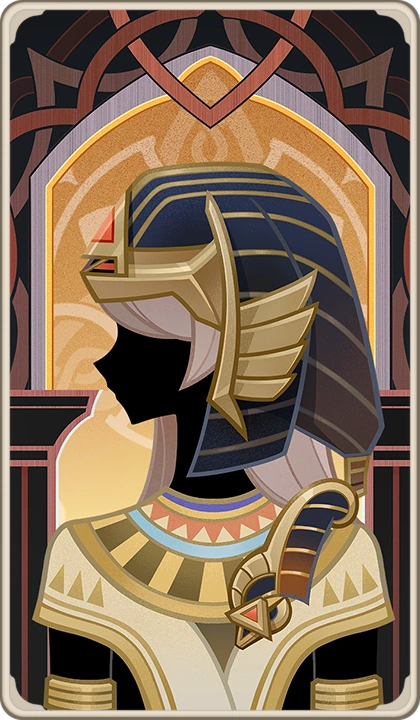
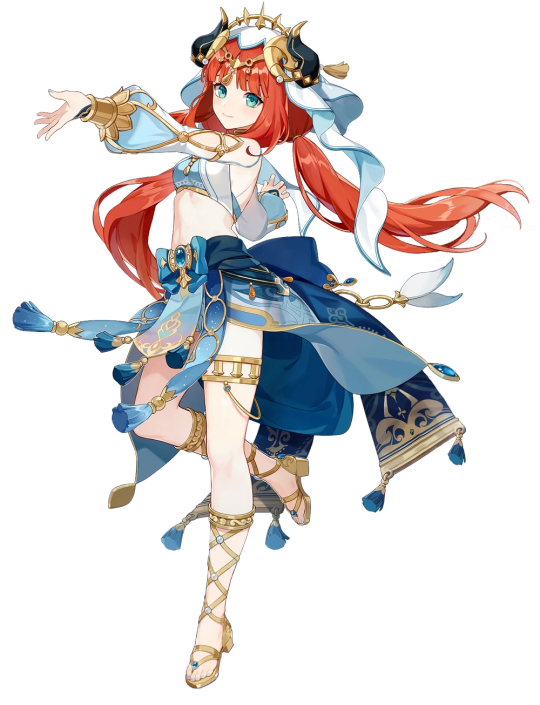
As of 4.7, we also have the Flower of Paradise Lost TCG card, which may depicted the Goddess of Flowers. The color scheme is purple and white, but the woman in the art is wearing a dress that looks similar to Guizhongs (delulu). The crown on this card has little wings, which are reminiscent of the winged helmet Mercury is sometimes depicted as wearing.
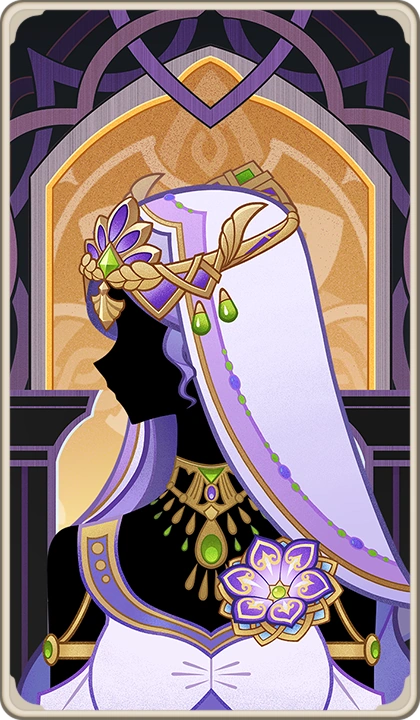
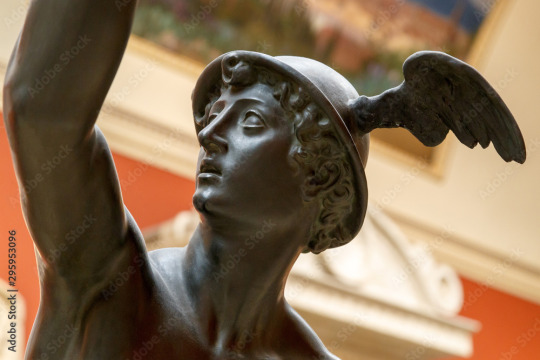
The defining feature of the chemical marriage is that the metaphorical union produces something greater than the sum of its parts. Sybilla and the Goddess of Flower’s sacrifices allowed the fulfillment of plans that were intended to create new worlds, something I would consider greater than the combination of god and Seelie minds. Another common thread in these transactions is wisdom, or lack thereof, with both Goddess of Flowers and Guizhong offering wisdom, and Sybilla saying that she no longer has hers - although that didn’t stop her from becoming part of Phobos. This theme of wisdom also has alchemical significance, since the philosopher’s stone is the lapis philosophorum; the 'stone of wisdom'. I’ve written a theory about the philosopher’s stone and Descenders and alchemy, including the chemical wedding motif, in the Narzissekreuz Ordo questions: you can check it out here. Two points that I want to carry over to this theory is that a) there is evidence to suggest that the philosopher’s stone and a Descender are the same in Teyvat and b) the ability to successfully change Fortuna (fate) is directly linked with Descender status. I’m not saying that Deshret and Remus were trying to become Descenders, but there are clear thematic parallels with their goals, and Rene’s goals. Additionally, these four examples are not the only time a union resulted in world changing consequences. Records of Jueyun recounts the story of the traveler from afar and the seelie: At a far-flung moment in the distant past, the ancestor of the seelie met a traveler from afar, with whom they swore an oath of union witnessed by the three sisters of the Lunar Palace. Just thirty days later, a sudden disaster struck. The seelie and their lover fled into exile as the world collapsed around them, fleeing until the terrible calamity caught up with and seized them. Their cruel punishment was to be separated from each other for eternity and to have their memories wiped without a trace. The book goes on to directly connect this union with the curse of the Seelies that Arama mentions: The graceful but heartbroken seelie and the sisters grew more sullen and withdrawn with each passing day, to the point where their wondrous forms withered away, leaving fragments of their former selves scattered in the mountains and ruins, where they turned into tiny little life forms. They had forgotten so much, lost so much, and been stripped of their voices and wisdom, yet they continued to sing the same songs of grief. Because of this, still harboring a shred of the deep love they once had for their long-lost lover, they will act as guides to travelers who stop in the mountain mist, seeking to retrace their memories of an ancient story in long-abandoned ruins, disused makeup cabinets, and now-undecipherable poetry. Moonlight Bamboo forest has another version of the story, where the three moon sisters loved the “stars of daybreak,” and after some kind of cataclysmic event, only one (dead) moon remained in the sky. Mitternacht’s Waltz also described a sword shattering one of the moons: Two of the three bright moons that caused the perfumed sea of the primordial universe to shine and stirred up the beasts of the Arianrhod Realm were shredded by a sword that tore the horizon asunder, left in smithereens too small even for the mystical sight of the Prinzessin. Ever since the Narzissenkreuz quests, I am very suspicious of all swords mentioned in lore. If we put all these themes and narratives together, another possible metaphorical union emerges:

Since the dawn of Genshin lore, there have been various theories regarding the duality in the designs of the twins, with some also suggesting that they are two separate halves of one being. However, I’d like to propose the opposite: if the twins follow the path of their fellow black/gold and blue/white predecessors, then it seems likely a fusion that is also a sacrifice is in the future for our protagonist. There are other similarities between the twins and the god-king/seelie pairs. The twins have sun and moon symbolism on their clothes, constellations, and swords: Aether’s has a star (sun) shaped hilt and Lumine’s a moon. The Traveler is frequently described as being ‘golden’ (ex. Golden Nara), and Liloupar says that they remind her of Deshret. The Traveler is already a Descender, but they definitely don’t seem to have the strength or knowledge to exercise their world-equivalent Will yet - and maybe their sibling who has been spending time in the Abyss and has learned the “truth of this world” can help. In that case, the knowledge of the Abyss-aligned twin would fulfill the role of the Seelie knowledge in this pair, helping the Traveler complete their power-up. But what about Paimon, the emergency food? She's the dove, representing the spirit and- [is dragged offstage].
P.S. I didn’t know where to fit this in, but I think Before Sun and Moon is also referring to a chemical wedding. Sun -> sulfur and gold, Moon -> mercury and silver. The title could be an incomplete phrase, and actually be something like “Before Sun and Moon joined.”
#genshin lore#genshin impact#genshin#genshin spoilers#smacks this post like it's the Pepe Silvia wall#i am so insane for these parallels#reblogs
129 notes
·
View notes